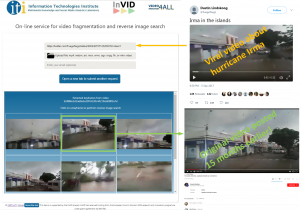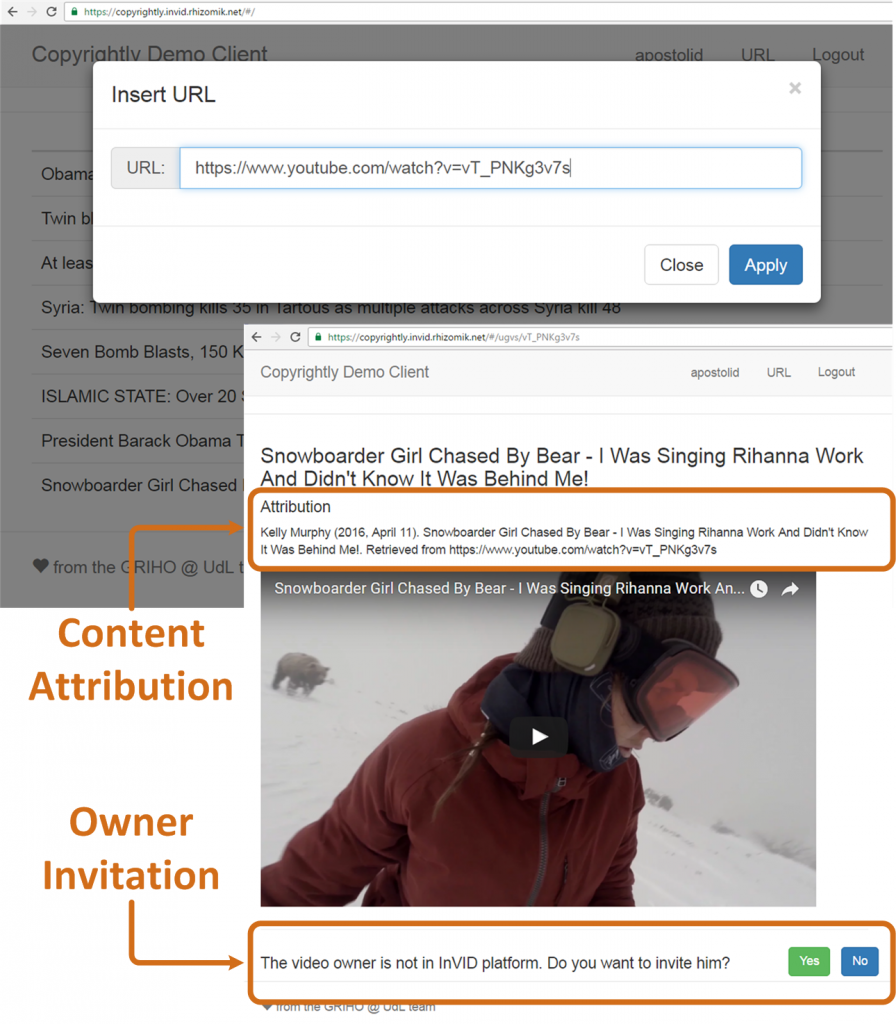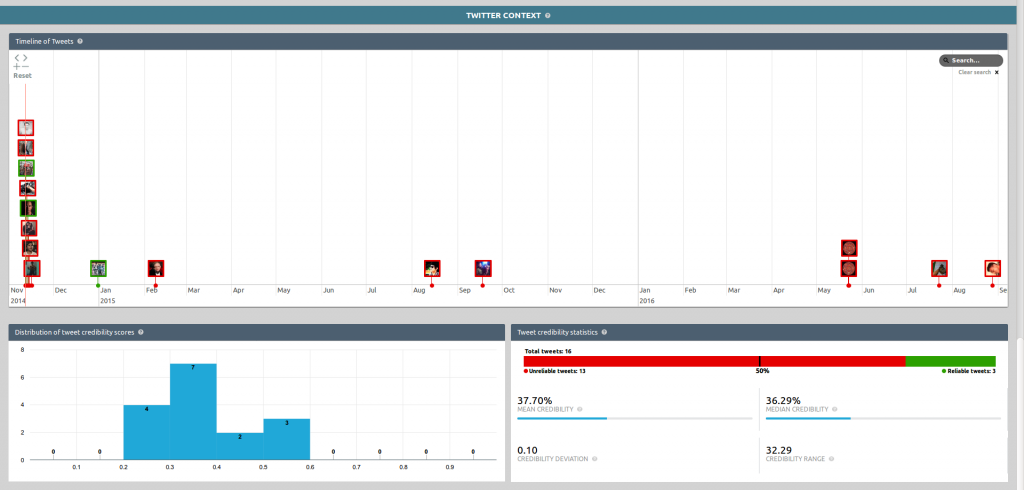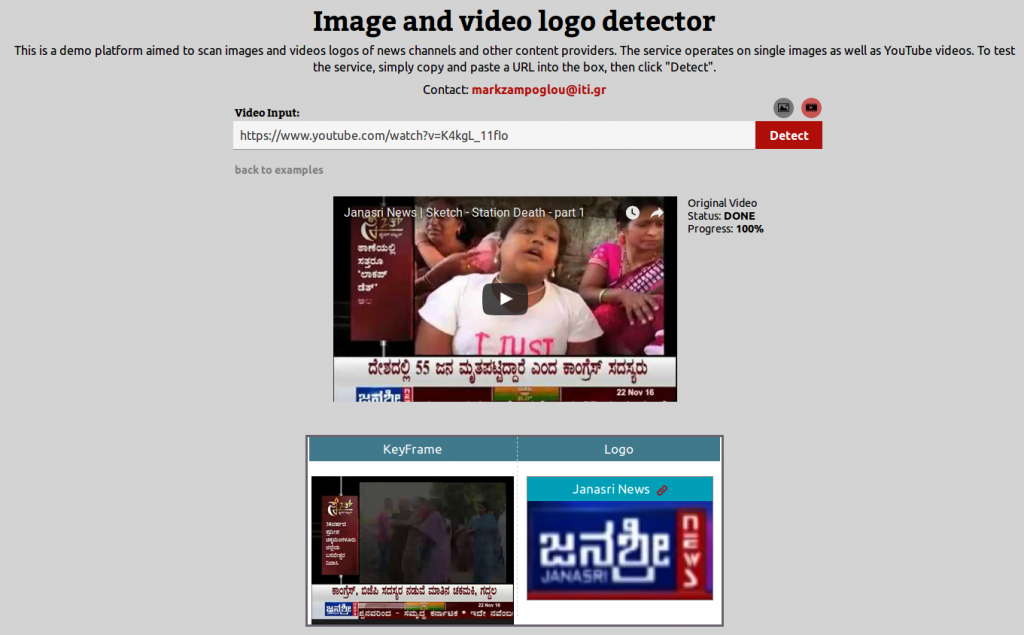This page provides details about the different InVID technologies that have been integrated into the complete InVID applications (i.e. the InVID Verification Plugin, the InVID Verification Appplication and the InVID Multimodal Analytics Dashboard), and act also as individual software components of the overall InVID platform.
On-line service for video fragmentation and reverse image search
This experimental service allows the user to extract a set of representative keyframes from a video, and to use these keyframes for performing reverse image search with the help of the Google Image Search functionality.
To submit a video for analysis the user can either provide its URL or upload a local copy of it from his/her machine (please notice that the maximum permitted video size is 2GB). The supported on-line video sources include YouTube, DailyMotion, Facebook, Twitter and Dropbox (beware though that not all videos from these platforms are accessible to our service, due to platform-specific or user-defined restrictions about the use of each specific video; moreover, the provided URL should always point to a single video, rather than a playlist of videos). The service can handle videos of mp4, webm, avi, mov, wmv, ogv, mpg, flv, and mkv format.
After submitting a video, the user can monitor the progress of the analysis. After its completion s/he will be shown the collection of extracted keyframes and be able to perform reverse image search by left clicking on each one of them. Alternatively, if the user provided an e-mail address (optional) s/he may close the plugin and be notified by e-mail when the analysis results are ready. This e-mail contains a unique link to the analysis results (i.e. the collection of extracted keyframes), that is active only for 48 hours; after this time period, the link, the submitted video, the analysis results and the e-mail address (if provided) are automatically deleted from our server. All video rights remain with the uploader, who is assumed to have the right to submit the video to this service for analysis.

On-line service for video fragmentation and annotation
This experiment![]() al service lets you submit videos in various formats and perform visual analysis algorithms on them: shot segmentation, scene segmentation and visual concept detection. The service allows the user to submit a video for analysis by uploading a local copy of it from the user’s machine (this is preferable), or by specifying the URL of a video available on-line. The service can handle videos of mp4, webm, avi, mov, wmv, ogv, mpg, flv, and mkv format.
al service lets you submit videos in various formats and perform visual analysis algorithms on them: shot segmentation, scene segmentation and visual concept detection. The service allows the user to submit a video for analysis by uploading a local copy of it from the user’s machine (this is preferable), or by specifying the URL of a video available on-line. The service can handle videos of mp4, webm, avi, mov, wmv, ogv, mpg, flv, and mkv format.
After fetching the video file, the service decomposes the video into shots and scenes. Following, a few hundred visual concept detectors are evaluated for each video shot, thus generating shot-level concept-based annotations. After submitting a video for analysis, the user may close the browser window and be notified by e-mail when the analysis results are ready; alternatively, the user may leave the browser window open, to see how the analysis progresses. In any case, when the analysis is completed an e-mail is sent containing the unique address at which the analysis results are displayed; the display is performed with the help of an interactive user interface, which allows the exploration of the video structure (shots, scenes) and the annotations, and the concept-based search within the collection of shots.
Rights Management Service
The first version of the Rights Management service has been released. This service aims to assist journalists through the process of clearing the copyright of User Generated Videos (UGV) that have been indicated as relevant and useful for presenting a story, in order to enable their reuse.
The service guides the journalists through recommended copyright management workflows, like the one proposed by YouTube that includes the provision of proper attribution and the contact with the content owner. If the latter is already registered in the InVID platform the communication is performed via the system, while in a different case a request for content reuse together with an invitation for registration to the InVID platform is sent by the service to the content owner. This registration can be made using social network credentials and facilitates the easier verification of the registered users as the content uploaders of their UGVs, and the effortless and timely acceptance or rejection of content reuse requests.
An online demo of this service is available at: https://rights.invid.udl.cat
The API of the service is accessible at: https://rights-api.invid.udl.cat
The documentation of this service can be found at: https://rights-api.invid.udl.cat/docs/index.html
A demo account for journalists can be provided by e-mailing to roberto.garcia@udl.cat

Explanatory illustration of the online demo for Rights Management.
InVID Context Aggregation and Analysis tool
The InVID Context Aggregation and Analysis application aims at assisting investigators in evaluating the credibility of videos posted online. Currently applicable to YouTube videos, the service collects, analyzes and presents contextual information from YouTube, Twitter and a third party weather API to assist investigators in evaluating the video.
With respect to YouTube, the tool presents in a concise format all information provided by the API, such as upload date and number of views, but also goes a step further by scanning all comments and keeping those that can play a part in verification (e.g. those claiming that the video is “fake”). It also extracts all location and date/time information from the video description, and allows the user to view a weather report for the reported date and location, so that investigators can easily compare it with the weather depicted in the video.
Furthermore, the tool searches Twitter for references to the video, and collects all relevant tweets. It presents them in an interactive timeline to allow for an overview of the Twitter traffic around the item, but also submits all tweets to the Tweet Verification Assistant service. Aggregate analytics over the submitted tweets are offered to the user, giving an overall estimate of the likelihood that the video is fake.

Screenshot of the Twitter context analysis for a YouTube video.
InVID Logo Detection tool
The InVID Logo Detection tool scans images and videos for logos, and provides background information on the respective organizations or groups with which they are associated. Currently, the tool has been trained to recognize a number of TV channel logos, but the logo dataset is extensible and the aim is to include more informal – and less recognizable – groups, such as paramilitary groups or independent journalistic organizations.
Given an image or a YouTube video, the tool scans it and detects any logos from its index. If a match is found, the user is provided with the logo name, the keyframe and timestamp where the logo was detected – for confirmation -, and a link to the Wikipedia entry providing more information on the organization associated with the logo.

Screenshot of the logo detection results on a YouTube video.
